|

Updated January 12, 2024
© 2002, 2024 LandingNewJersey.com. All rights reserved,
do not use without permission.
The history of Landing, in Roxbury Township New Jersey is intertwined with the
histories of Lake Hopatcong, Mount Arlington, Hopatcong Borough and Morris
County. In this short overview we will focus on Landing, while understanding how
these communities were interrelated.
The history of Landing New Jersey is tied to three major developments:
- The opening of the Morris Canal as an early commercial transportation
route starting in 1827
- The rise of busy railroad traffic through Landing and the railyards of Port
Morris starting around 1870
- The blossoming of Lake Hopatcong as a major Summer resort and tourist area
starting around 1890.
THE COLONIAL
PERIOD
1600's - - The Nariticong clan of the
Delaware Indian Nation live on the east shore of Lake Hopatcong, with a large
village on Halsey Island, which was at that time connected to the mainland.
Dutch trappers start to have contact with the Nariticongs and with other Lenape
Indians. In 1633 the Dutch established trading outposts in what became
northern New Jersey.
1664 - -New Jersey becomes an English colony. Groups of Puritans settle Newark
in 1666 and move inland.
1700's -- In the early 1700's, Native Americans began to sell off their land and
leave the area. In 1708 they sold a large piece of land that included Roxbury
Township. The deed for this transaction was written on an 18" x 28"
piece of parchment and is still quite legible. It is available for viewing at
the New Jersey Historical Society Museum in Newark. Around this date the first
group of white settlers established homes in the area that became known as
Landing. They belonged to a devout Christian group known as Rogerenes (or Rogerines),
named after their founder, John Rogers of Connecticut (1648-1721). Some date
their arrival in the Roxbury area as early as 1702, others as late as 1736.
Their theology was similar to the Seventh Day Baptists and their practices much
like the Quakers. The center of the settlement of about 20 families was Mountain
Pond, it's name changed around 1912 to Lake Rogerene (or Lake Rogerine), long
after the group had left. Their modest farms extended to the southern end of
Lake Hopatcong, with a small cemetery in the Shore Hills section of Landing. By
1800 most had left the area, some joining another Rogerene group in South
Jersey, others heading for Ohio or Virginia, while some others stayed in the
area, blending in with the general population.
1740 -- On December 24, 1740 Roxbury was incorporated as the fourth township in
Morris County. Within its boundaries at that time were the areas that later
would separate and become Chester Borough, Chester Township, Mt. Arlington, Mt.
Olive Township, Netcong Borough and Washington Township, in addition to parts of
Hopatcong Borough and Stanhope. As a result of several of these communities
pulling away and becoming independent over the years , Roxbury Township is now
comprised of Succasunna (formerly Suckasunny, name changed 1888), Ledgewood
(formerly Drakesville, name changed 1891), Kenvil (formerly McCainesville), Port
Morris, Landing and Lower Berkshire Valley. Roxbury Township is
just under 22 square miles in size.
1750's -- Lake Hopatcong was called Great Pond. Around 1750 an Iron Forge is built by
New York City businessman Garret Rapalje near the southern end of the Lake at
the point where it flows into the Musconetcong River. Called the Brookland
Forge, it was located on what is now the Hopatcong State Park and it operated
for at least 30 years. A dam built for the forge raised the Lake level by 6 feet,
submerging areas of shoreline and cutting off Halsey Island and Raccoon Island
from the mainland. The Lake became known as Brookland Pond.
1758 - - The "Treaty of Easton" completes the sale of Lenape Delaware
Indian land to European settlers.
1776 thru 1783 -- Roxbury Township and the surrounding area become an important
hub for producing Iron Ore and cannonballs to supply General George Washington
and the Continental Army.
THE CANAL &
RAILROAD COME TO TOWN
1804 -- The Essex - Morris - Sussex Turnpike is completed, running through
Roxbury Township, a reliable Wagon Toll Road that sped up the movement of people
and goods from the cities of the northeast to the wilds of northwest New Jersey.
Specifically, the road went from Elizabeth, through Chatham, passed through
Madison in almost a straight line, skirted Washington's headquarters in
Morristown; ran along Sussex Avenue in Morristown, and continued through
Succasunny Plains, Drakesville (Ledgewood, the same route as today's Rt 46) and Stanhope to Newtown.
1822 - -While fishing at Lake Hopatcong, George P. Macculloch (whose house in
Morristown still stands) dreamed up the idea of what was to become the Morris
Canal. The canal was chartered in 1824 and would be an inexpensive way of moving
large quantities of coal, timber, iron ore and other goods across New Jersey. It
was designed by Professor James Renwick of Columbia College, the first American
canal to climb hills. The Morris Canal would run for 103 miles joining the
Delaware River at Phillipsburg with the Hudson River, a mule-drawn barge trip
that took about 5 days.
1827 -- The canal company, having acquired the property, builds a new dam on the
Lake to use the large body of water as a canal reservoir. A lock is built that
raised boats to the level of the Lake. A bypass valve controlled the water
flowing into a feeder canal that connected the Lake to the main canal. Lake
Hopatcong was the Morris Canal's largest reservoir. The Lake was entered through
a feeder of the Morris Canal. It then went to the lock at Brooklyn (a little
settlement which gave the Lake the name of Brooklyn Pond.) Hopatcong State Park
contains Morris Canal remains. In this park, to the left of the beach, is
a huge iron waterwheel on display, from Plane No. 3, which operated chains,
later wire cables, pulling up the boats. At the gate control house, the visitor
can see the locks under water at the edge of the Lake. Also here are the
gatekeeper's and paymaster's house (built about 1830, still standing). West of
the pumping station and the turbine, the broad open space was the basin of the
old canal, which from here went to Lake Musconetcong. There were 23 separate
inclined planes along the Morris Canal. Set in giant cradles, boats were hauled
up rail tracks by chains to water levels as high as 100 feet. As different
sections of the canal were completed, they were opened up for local use. On
November 4, 1831, the first complete trip from Newark to Phillipsburg was
completed. The canal was 90 miles long; and, the trip from Newark to
Phillipsburg took about five days. The first full boating season was 1832. When
it was completed to Newark in 1831, the actual cost was $2,104,413. In 1836 the
eleven mile extension to Jersey City was added.
1830's -- A small community known as Brookland develops around the canal lock in
what is now Hopatcong State Park. Another dam raises the Lake water
level 6 more feet and the Lake becomes known as Lake Hopatcong and over
time the name Brookland changed to Brooklyn after NYC's Brooklyn.
1834 -- Charles Shipman, a partner in the Morris Canal Company, builds a sawmill
near the top of Canal Inclined Plane Number 1 East, in the area now known as
Shippenport. The Mill was powered by the 'bypass' water from the Plane.
|
1844 -- At Shippenport an Iron Forge was built by John Slade, to run by the
'bypass' water of the Morris Canal in summer after it powered the sawmill, and
by a small natural stream at other seasons. It was located near the lower end of
Shippenport Rd. The ore came from the nearby Mariot's Mine and the Gove
Mine near Mountain Pond/Lake Rogerene. This forge was enlarged by new owner
Anson G.
P. Segur (a Dover banker) in the 1870's, and was still in working order when Munsell wrote of it
in 1882, although it would have been small and primitive by post Civil War
standards. Operations were discontinued circa 1885. The photo of its' ruins at
right is circa 1895, and clearly shows the Bellows Wheel and Hammer
Wheel. Photographer was Vernon Royal, who documented many area forges.
The sawmill was 150 yards uphill. Alternate names for this busy area were Shippensport, Shipmansport, &
Shippingport.
Photo courtesy
of Joe Macasek. |
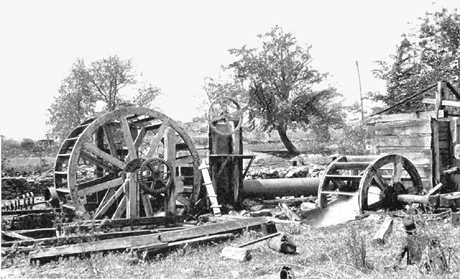 |
1850's -- The tracks of the Morris and Essex (later taken over by the
Lackawanna) Railroad are laid through the area in 1854, but no station is built
in Landing. Passengers going to Landing/Lake Hopatcong left the train at the
Drakesville (now Ledgewood) crossing, and were carried by horse drawn carts over
the bumpy roads up to the Lake.
1865 -- The Ogden Mine Railroad was built to carry iron ore from the mines in
the hills of Jefferson Township to Nolan's Point at the north end of Lake
Hopatcong, a distance of ten miles. This ore was transferred to canal boats
which were towed by a steam tug across the Lake to "Brooklyn" lock.
The boats went through the feeder to the main canal and then east or west
depending upon their destination. The company derived at least 50,000 to 60,000
tons of ore freight a year from this business.
1866 -- The most prosperous year of the Morris Canal as it carried almost a
million tons of freight. Among the commodities carried were lumber, coal, and
iron ore. The canal's business will now dwindle as the faster railroads start to
lure away the canal's customers.
1875 -- The railroad company orders the building of the iron steam tug
"Lake Hopatcong" in Camden and it is sent to the Lake by canal.
1875 -- R. L. Edwards, a Wall Street banker, summers at Lake Hopatcong. He
purchases a 60 acre piece of land on the west shore at Bishops Rock and
Bonaparte Landing. Edwards builds his "cottage," known as Wildwood,
only one of four houses at the time on the west shore and becomes the founding
father of Hopatcong Borough. At his own expense he built a 7 mile wagon road to
Landing to facilitate purchases since Hopatcong had no stores at that time.
1880 -- During 1880 the amount of Iron Ore carried by the Morris Canal was
108,000 tons. With a boat normally carrying seventy tons, over 1,540 boat loads
were needed to move this cargo. When you consider that the Canal did not
"run" on Sunday and during the coldest part of the winter (frozen
water), those 1,540 boat loads had to be moved over a span of less than 280
days, an average of over 5 Iron Ore boats per day, not to mention the additional
boats for Coal, Timber and other products. This was the last "big"
year for Canal shipping.
1881 -- Much of the Canal Iron Ore business was lost when the Central Railroad
of New Jersey took over the Ogden Mine Railroad and laid track to connect it to
the NJ Central RR High Bridge Branch in 1881. Commercial shipping on the
Canal would dwindle during the next 2 decades, the quicker railroads having
taken much of the business.
1880s -- Hundreds of local residents are employed in the Lake Hopatcong Ice
Industry, cutting Ice on the lake and shipping it by rail to Newark, Paterson
and New York City areas before the days of electric refrigeration. Five
commercial Ice Houses are around the Lake, with the 'Mountain Ice Company'
having a very large Ice House in the Silver Spring section of Landing, off
Yellow Barn Ave., near the site of today's Nixon Public School.
A detailed 1887 map of Landing shows Dynamite and Gunpowder works on the grounds
of the American Forcite Powder Mfg. Co., later renamed the Atlas Powder Co.,
located on the southeast shore of Lake Hopatcong. Eventually Atlas would have
almost 130 buildings, barns & sheds on their 400 acres that spanned the area
along the Lake & up the hill from Shippensport Road to what is today Rogers
Drive. A Railway spur from the Lackawanna served both the Ice House and
the Explosives Company. The King brothers, Theodore F. King and William E. King,
ran 2 stores on the corner of Lakeside Blvd. and Landing Road. During this time
the bridge over the canal and railroad in Landing was made of Iron with wooden
planks as a roadway. In the early 1880's the Lackawanna Railroad built a
Passenger Station at Drakesville (modern day Ledgewood). Horse drawn
carriages would then take people up the bumpy road to the lake. By 1886
the Landing/Lake Hopatcong Railway Station on the Lackawanna Line was built.
Steamboats would wait on the Morris Canal in Landing for the passengers to
disembark from the train.
1886 -- The "Lake Hopatcong Steamboat Company", commonly known as the
Black Line, was founded. The company provided service from the "new"
Landing railroad station, built around 1886, to all areas of the Lake by means
of a 'feeder canal' that traveled from the Lake at the area of the State Park
and connected to the Canal in the area of the current Landing Shopping Center.
(The Canal ran parallel to the RR tracks in this area) From there the boats used
the Canal to come right up to the Rail station platform, where passengers simply
crossed the platform to board the boat sitting in the Canal. (the south end of
the Lake was extremely shallow at that time with only rowboats able to pass).
The trip back to the Lake took them through the Canal Lock, where the boat was
raised to the Lake's higher level. The Lackawanna Railroad, the Black Line &
the Canal cooperated in business.
THE LAKE BECOMES
A SUMMER RESORT
1890's -- This era saw the blossoming of Lake Hopatcong as the Summer Resort of
choice by both the wealthy and the newly middle-class. The wealthy would rent
large furnished houses, (called cottages!!) on the waters edge. The middle-class
would often set up large canvas tents on wooden platforms and dwell in these for
a week or more. All would enjoy the cool "mountain air" afforded by
the advertised "1,200 foot elevation of the Lake" (an exaggeration of
its' actual 926 foot elevation), a welcome summertime relief from the sweltering
cities. Many would come up for the weekend and stay in one of the Hotels or
rooming houses that sprang up around the Lake. Most everyone traveled to the
Lake via Train, disembarking either at the Central Railway of New Jersey Station
at Nolans Point or at the Landing Station of the Delaware, Lackawanna &
Western Railroad. From there they most often traveled to their Lakeside
destination via Steamboat!! The roads were poor to non-existent, and besides,
the Steamboats were part of the attraction of the Lake! With a growing cluster
of Hotels and luxury homes, Mount Arlington was
created on November 1, 1890 by splitting away from Roxbury Township. The odd,
twisting border between Landing/Roxbury Township and Mt. Arlington seen on maps
was created when certain precincts voted to secede, while others did not.
| In 1890 the
"Hopatcong Steamboat Company", known as the 'White Line' was
founded by Theodore F. King to compete with the established "Black
Line". This was a bold move, as the "Black Line" was
owned by the same financial syndicate that owned the Lackawanna Railway
and the Morris Canal. They had the ability to tax all boats using the
Morris Canal and it's "feeder extension", which ran from the
deep water of the main part of the Lake right up to the Landing RR
Station. It seems that King tried either to undercut his
competitor, the Black Line, by avoiding the Morris Canal tolls or could
not come to an agreement with them so he used small boats to ferry
people from the shallow dock at Landing to his Steamboats waiting a half
mile away in deeper water. The Black Line charged passengers a fifty
cent fare each way from the railroad station, a sizeable amount in 1890
! Experienced travelers knew that after they got off the train they
could walk across the bridge at Landing and board one of King's boats
which only charged a twenty-five cent fare to go out to the hotels and
forty cents to return. In July 1891, the Morris Canal and Banking Co.
retaliated by lowering the water level on the lake. This resulted in the
White Line not being able to operate their small boats from the Landing. |
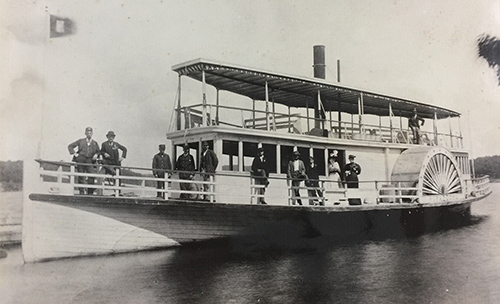
The largest Steamship on
the Lake, the White Line's double-decker side-wheeler
"Hopatcong" at Landing dock, circa 1905. Other White Line
boats were the single deck side-wheelers Alametcong and the
Musconetcong. Smaller boats were the Flossie II and the Nariticong. |
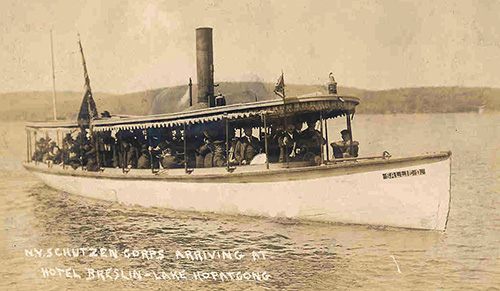
The "Sallie D" fully
loaded. |
Undeterred,
Theodore King responded by dredging the swampy area at the southernmost
part of the Lake, thereby creating Landing Channel which made it
possible for White Line steamboats to come within a block of the
Landing Rail Station. The Black Line and The White Line boats continued
to compete for passengers. The Black Line boats were painted black and
were mostly identified with work from the Canal, being able to pick
people up at the Landing Rail Station as the Canal used to run within
yards of the platform. The White Line was strictly for travel on the
Lake itself. If a passenger along the shore wanted a ship, they would
hoist a flag from the dock of their Hotel. The boats made connections
with the trains, or the boats could give you a ride up and down the
Lake. The boats had such names as the 'Mystic Shrine', the Sallie D, the D. L.
Bryant, the Bessie Williams, the 'Andrew Reasoner', the Dream, the Uncle Dan and the 'Fanny'. |
1890s -- the Jersey Central carried 50,000
persons every summer to Nolan's Point where amusement and picnic parks were in
existence. The railroad has tracks that followed the shore of Nolan's Point and
then swung into Minisink and Morris County Junction.
The Nolan's Point Villa was considered to have been the best of the Lake hotels,
costing $2.00 per day. The Hotel Breslin in Mt. Arlington was the most popular
as it was large, had terraces, spacious flower beds and a great view of the
Lake.
At times more than 500 people arrived all at the same time at the Lackawanna
train station at the south end of the Lake.
1892 - On April 18 the explosive works of the American Forcite Powder Company, a
short distance from the train station, blew up in a series of blasts killing
seven men, including J. D. Smith, the Superintendent. This brought about
pressure to scale down the scope of the operations, which was done, until World
War I demands brought it back to full operation for a short time.
1898 -- Hopatcong breaks away from Byram Township and establishes its own
municipality, the Borough of Brooklyn, later renamed Hopatcong. Brooklyn had
three hotels, no churches and no stores..
1900 thru 1939-- Eventually there would be over 40 hotels and rooming houses all
around the Lake to handle the tourists. The Lake became a popular destination
for Vaudeville stars who had time off in the summer when most theaters closed.
The entertainers associated with the area as summer residents or tourists
included Bert Lahr, Joe Cook, Jeanette MacDonald, George Burns and Bud Abbott.
During this time, Henry Scheer (1860-1933), of the influential Scheer family of
Ledgewood, built and operated the Silver Spring Park on Lake Hopatcong, in
Landing - a truly remarkable hotel, offering a steam merry-go-round, a shooting
range, a ball field, boats for rowing and fishing, and a "fine line of
confectionery".
| 1901 -- Hudson Maxim, born in 1853, is a
scientist and inventor who comes to the American Forcite/Atlas Powder
Co. in Landing as a leading researcher. He was involved with improving explosives and made the
first smokeless powder in the U.S. It was adopted by the U.S. Army. In
1901, he invented Maximite, a high explosive bursting powder 50% more
powerful than dynamite. When used in torpedoes, Maximite resisted both
the shock of firing and the greater shock of piercing armor plate
without exploding until it was then set off by a delayed-action
detonating fuse, another Maxim invention. He purchases much land in
rustic Hopatcong, sub-dividing it into house lots and contributes
greatly to commerce around the Lake. He regularly has well known guests
at his Estate House, Maximhurst, built in 1904. His famous castle-like
boathouse on the Lake was completed in 1906. During this time Maxim was a
familiar sight around the Lake, careening along the dirt roads at high
speed in his open car, all the while steering with just one hand, his
other was blown off in an explosives experiment. Maxim died, amazingly, of
natural causes in 1927. |
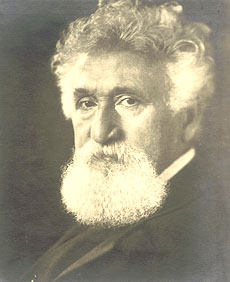 |
1908 -- The "New" Landing Bridge is
completed. Built of stone and masonry, it continues to stand to this day.
Trolley service comes to Landing. The Morris County Traction Company Trolleys
come from Dover and up to the Lake. The tracks were built over the new bridge in
1908, and extended up Mt. Arlington Blvd. to the picnic area and beach at Bertrand
Island in 1910. The clubhouse for
the Lake Hopatcong Yacht Club is built on Bertrand Island. The "Lackawanna
Cut-off" begins construction across New Jersey at this time, it is a
Railway Engineering marvel, running in a straight level line from just north of
Port Morris to the Delaware River. Instead of following the contours of the
land, it uses massive amounts of fill and long bridges to traverse valleys. The
two large arch bridges which still stand and cross Center Street in Landing/Port
Morris are the starting point.
1912 -- The Mountain Ice Company in the
Silver Spring section of Landing has a huge wooden storage hanger, which
burns to the ground in a fire so large the flames lit up the sky all around the
Lake. In 1913 an even bigger storage building was built in a fireproof
construction of a steel frame and two layers of sheathing of hollow ceramic tile
with insulating properties. At the time of it's construction, it's 56 foot
height made it the largest Ice House in America. It was said to be able to hold
100,00 tons of ice. It was the largest single-span construction in the USA until
Radio City Music Hall was built. It stood near the current day Nixon School.
With the advent of electric refrigeration, it closed in 1935 and was torn down
in 1939. For years afterward, Children would play on the large mounds of brick
tile left at the site after the demolition. Nearby, the home of the plant's
Superintendent, the 'Cary' or 'Carey' house, built with the same tile exterior,
still stands at 285 Mt. Arlington Blvd.
1918 - - Explosives used in railroad building
and mining had been manufactured in the Landing area for many years. As World
War One raged, demand for explosives was up, and many workers were added, with
the Hercules Powder Company renting the entire Westmoreland Hotel for their
employees.
1920 - - On December 14 an Explosion
Destroys a Building of Atlas Powder Company at
Landing, killing four men. The building, in which dynamite was made,
was scattered over half a mile of ground and only a ten-foot hole
marked the place where it stood. (NY Times quote emailed by Ralph)
1920s -- The Lackawanna Railroad route, with its' station in Landing, becomes
the predominant rail link to Lake Hopatcong, surpassing the Central
Railroad of New Jersey station at Nolan's Point. With decreasing Government
purchasing after WW I, and increasing land values, the Atlas Dynamite Powder Co.
ceases operation in 1923. In 1922 the Westmoreland Hotel (near the site of
today's Station Hardware) had a fire and closed. Shortly thereafter, in 1925, a
Restaurant called 'The Westmoreland Dining Room' opened a short distance away at
130 Landing Rd to serve customers who were regulars at the popular Hotel
room.
1924 -- The formal shutting down of the Morris Canal as well as the removal of
the Steamboat Dock at Landing.
1925 -- The current dam is built in what became the State Park.
1928 -- Two significant events this year: The death of Theodore F. King and the
Morris County Traction Company trolley from Morristown through Landing and up to
Bertrand Island ceased operation in February, replaced by a bus line.
1930's -- With the Economic Depression of the 30's, people no longer
"weekend" at the Lake in large numbers. The Grand Hotels around the
Lake start closing, including the last one in Landing: The Silver Springs Park
House. Though the Hotels were gone, a number of Restaurants around the Lake
became popular, including 'The Westmoreland Dining Room' on Landing Rd, which
was operated by Johnny Apostolik, brother of Walter Apostolik, the Editor of
'The Lake Hopatcong Breeze'. Johnny served both local residents as well as
"Show Business Folks" who either vacationed at the Lake or who were
performing in Summer Stock. Some of these 'Summer tryouts' for Broadway took
place at the "Lakeside Summer Theatre", located in the building that
now houses Leber-Lakeside Funeral Home on Landing Road. Some of the shows here
from the 1930's thru the 1950's were directed by Herbert Machiz, a
Broadway Theater Director, who though not well known to the public, was highly
regarded by leading actors of the day. Summer performers here
included Jackie Coogan, John Carradine & Bela Lugosi. One of the regular summer performers
during this era was Orson Wells, who maintained an active running 'tab' at the
Westmoreland Bar.
THE MODERN ERA
1945 - Present -- The post war building boom comes to Landing, with
many fine
suburban homes built and older summer homes converted to year round
use. In
1947, a fire took the Obdyke General Store/Landing Food Market at the
southwest
corner of the Landing 'hub'. This opened the way for the 1950
Construction of
the Emmet Supermarket. In 1961 a new Post Office is built on Lakeside
Blvd, and
the old small stone octagonal building at the corner which had served
that
purpose became a Real Estate Office until it was torn down around 1970.
During
the post war years, Landing children attended the Elementary School in
Port
Morris. In 1969 Nixon
Elementary School was completed, leading to the closing down of the old
Elementary School in Port Morris in June, 1971. A prominent name during
this
time was Emmanuel 'Manny' Selengut, who as owner of much property in
Landing,
developed the "Shore Hills Estates"area in the 1950's & 60's, building many
homes through his Company, S & S Construction. Many of the streets
in Shore
Hills are named after his family and friends, i.e; Mansel Dr. = Manny
Selengut; Davesel, Henmar, Edith and Dinah are others.
Some other streets are named after historical figures including Vail, Rogers,
Logan, Morse, King & others (sounds like a good subject for a new web
page!). Chaplin Builders constructed other homes during this time. In the early 1970's the
Landing Shopping Center was built on Lakeside Blvd, filling and paving over a
small pond and section of the Morris Canal where children would go to catch frogs.
In 1980-81, one of the two roads that connected Landing with Netcong, Kings
Highway, was blocked and closed at the Netcong border, leaving Center Street
through Port Morris our one link to Netcong.
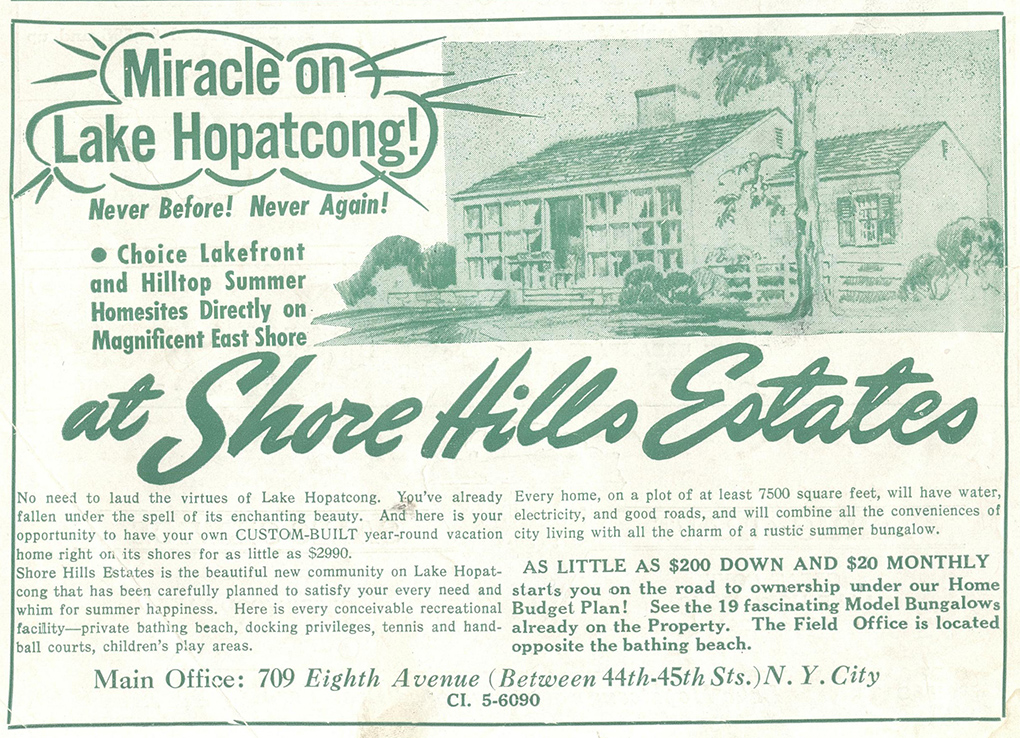
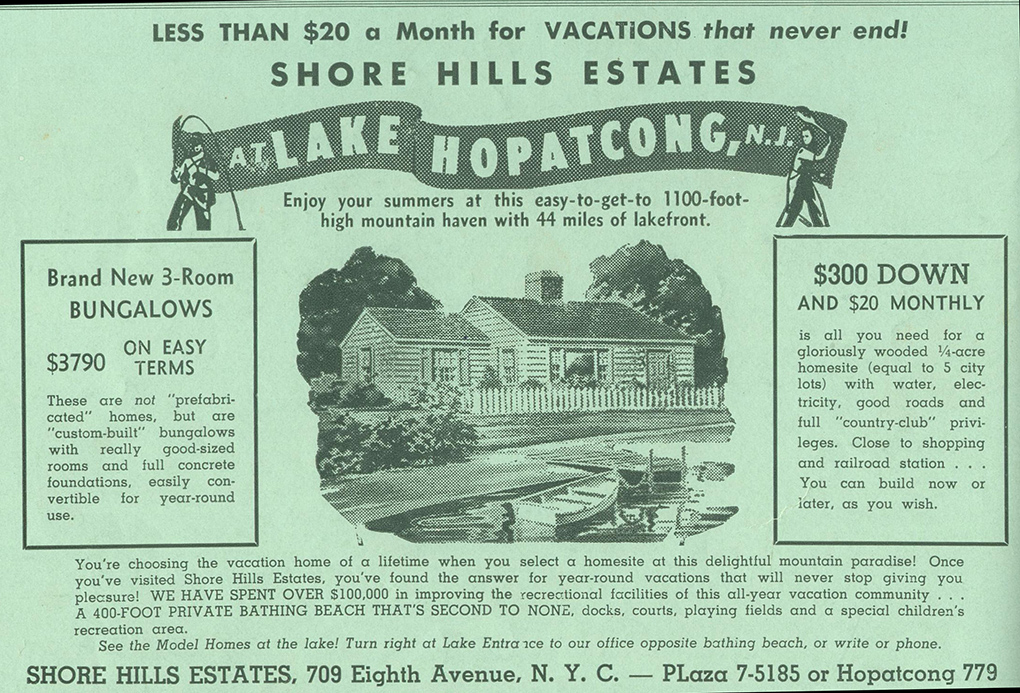
2015 - The new Landing Park Recreation Complex was dedicated. Consisting of 4
Baseball/Softball fields, a Picnic Grove, Playground, Walking track and
Concession stand, it will used by all Roxbury teams. Also in 2015, the
Shippenport Road firehouse home of Roxbury Fire Co. 2 was doubled in size to
accommodate modern fire trucks.
2022 - State of New Jersey completes
purchasing 2 buildings near the Landing Bridge in preparation for tearing them
down and building a new bridge with double the width, and a wider roadway
approach. Demolition is planned for Spring 2023, with Bridge construction to
start thereafter. Two lanes of new bridge will be built before old bridge taken
down, then 2 final lanes added.
Even with all the new homes built, many remnants of the Landing of 100 years ago
remain, including:
The Canal Lockkeepers House at the State Park (circa 1830), the Landing Masonry
Bridge (long may it stand!!), the brick and stonework foundations of the Morris
Canal and Saw Mill off Shippenport Rd., the Railroad Station Building on
Landing Rd., several houses on Lakeside Blvd, several houses on Shippenport Rd,
the thick reinforced concrete bunker walls of the Atlas Dynamite Powder Co.
still visible on Mt. Arlington Blvd near Rogers Rd, (and many more of their
walls now buried), several ponds off Shippensport Rd and behind the Gulf Sta.
which were formed when fill was taken from them for the Railroad bed in the
1850's, the 'Carey House', at 285 Mt. Arlington Blvd., the King Cottages in the
Kingsland section and several houses along Center Street in Port Morris which
were stores at the turn of the century.
© 2002, 2017 LandingNewJersey.com. All
rights reserved, do not use without permission.
This page can only begin to cover the
rich history of Landing. Although this site is an independent effort, we
appreciate and commend the work of the 3 area Historical organizations:
1. We recommend a visit to the Lake
Hopatcong Historical Museum
at the State Park, open Sunday afternoons 12-4 PM in the Spring and Fall. Lake
Hopatcong Historical Museum, PO Box 668, Landing, NJ 07850 tel#
973-398-2616. Members receive their informative Newsletter. Join!!
2. The "King Store" at 211
Main Street in Ledgewood, operated by Theodore F. King from 1874 through 1928,
is now open for short tours on the second Sunday of each month from 1-4 PM.
Operated by volunteers from the Roxbury Historic
Trust, this is well worth a
visit. Books detailing Roxbury and local history are on sale, along with
souvenir postcards. The Trust is also restoring the 1881 King Victorian House.
Roxbury Historic Trust Inc., 209 Main St, Ledgewood, NJ 07852 tel#
973-927-7603 or 973-584-7903.
3. The Roxbury Township Historical Society operates the historic Silas Riggs
'Saltbox' House at 213 Main Street in Ledgewood, usually open on the second
Sunday afternoon of each month. They also sponsor an evening lecture series,
open to the public, as well as the very popular "A Saltbox Christmas",
an Open House with an Olde Fashioned Christmas Soup Supper, held in early
December, free to the public. They work co-operatively with the Historic Trust,
together staffing the 3 buildings that make up the Ledgewood Historic District.
Roxbury Township Historical Society, PO Box 18, Succasunna, NJ 07876. tel#
973-584-6931 or 973-584-2676.
Information for this page came from
a variety of sources, including:
Beck, Henry C. "TALES AND TOWNS OF NORTHERN NEW JERSEY".
1964. Rutgers University Press.
Bolles, John R. & Williams, Anna B. "THE ROGERENES",
1904, Stanhope Press, Boston.
Crayon, J.P. "Rockaway Records
of Morris County, N.J. Families". 1902
Hosking, Annie S. & Meeker, Harriet "THE HISTORY OF ROXBURY
TOWNSHIP" Vol. I & II Roxbury Township Historical
Society
Kane, Martin. "HOPATCONG - A CENTURY OF MEMORIES" ,
Arcadia Publishing
Lee, James. "TALES THE BOATMAN TOLD" 1973, reprinted by Canal
Press 1989
Lewis Publishing, "Biographical History of Morris County New
Jersey".
1914
Lum, Edward H. "Genealogy
of the Lum Family" 1927
Macasek, Joseph. " GUIDE TO THE MORRIS CANAL IN MORRIS COUNTY"
1996
Munsell, W.W. "History of
Morris County, New Jersey", 1882, reprinted in 1967 by
Morris County Historical Society
Murray, Stuart A.P. "HISTORY OF HOPATCONG BOROUGH" ,
1976 Hopatcong Bicentennial Committee
Seraly, Ruthann & Lyman, Frances; "OLD HOMES OF ROXBURY TOWNSHIP",
Roxbury Township Historical Society
Thompson, Mary Wolfe. "THEODORE FRELINGHUYSEN WOLFE", 1961,
privately published
Wolfe, Theodore F. THE ROGERENES, an article in THE DOVER IRON ERA,
July 18, 1890
ROXBURY HIGH SCHOOL YEARBOOK, 1929
The Lake Hopatcong
Historical Museum, PO Box 668, Landing, New Jersey
07850
"THE LAKE HOPATCONG BREEZE" - Various Issues
plus Oral Histories from Tom
Valiante, Barb Seckler, George Vesel, Charlie B., Joe F. and Don T. shared with
the Website Editor.
This page includes much original research by the Editor. If used elsewhere, this
website must be cited. Info About the Heartland of America:
Heartland America Company | Changing the American Heartland | States in the Heartland America |


![]()